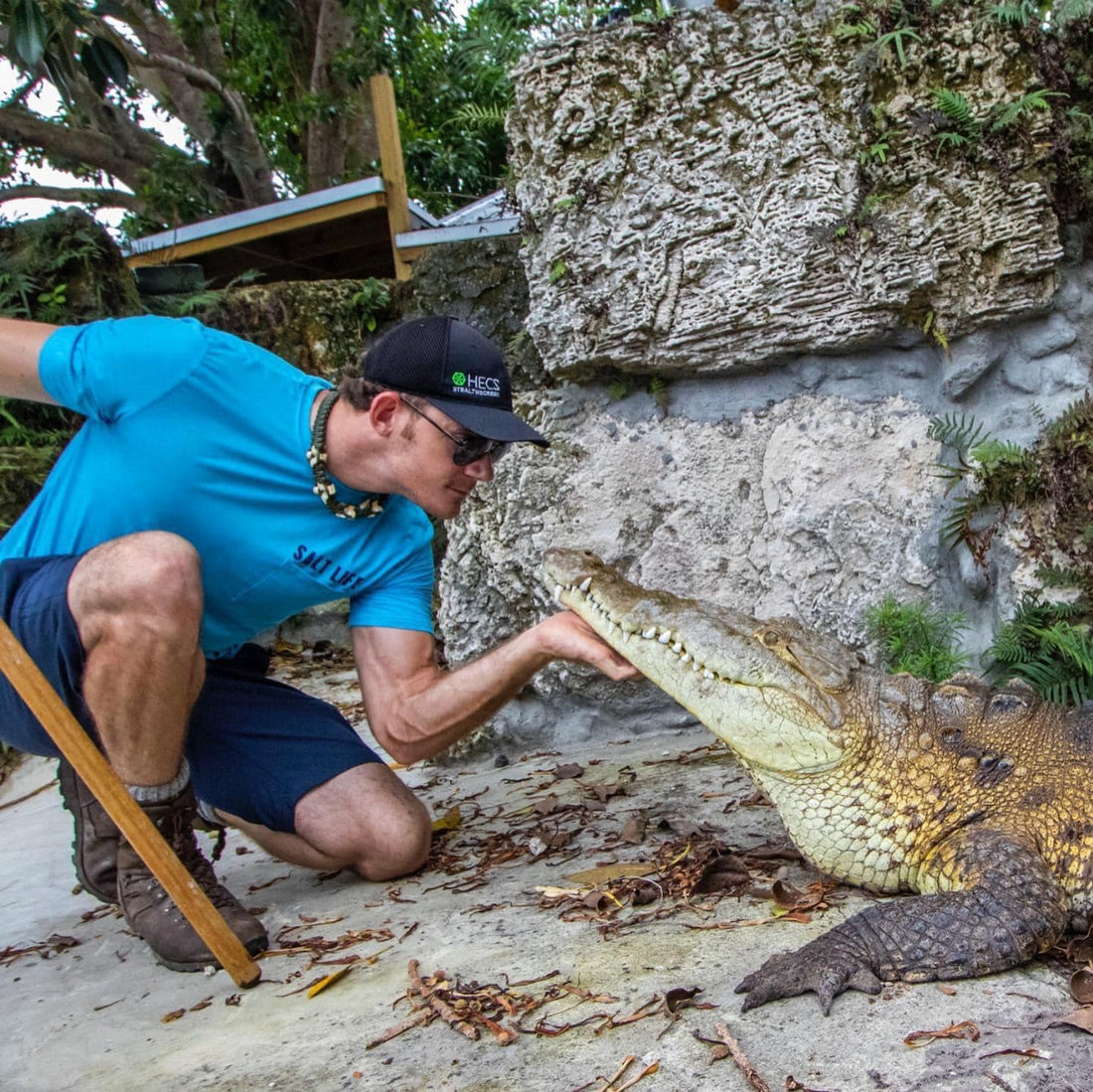When discussing animal training, reptiles aren’t typically the first species that come to mind. Can they be trained? The answer is, yes! Reptiles can all experience training in some capacity, but some species such as various varanid species, some larger chelonians, and crocodilians possess higher levels of intelligence, making training with them especially beneficial to their mental and physical well being!
We interviewed three keepers with different areas of expertise to get the inside scoop on all things reptile training! If you are unfamiliar with the various methods of animal training and how they can be used, check out our article on Methods in Animal Training for an introduction to this topic!
Let’s meet our reptile training professionals!
Introduce yourself:
Ryan: I’m Ryan Martinez, an Animal Care Specialist II in the ectotherm department at Zoo Miami.
Chris: My name is Chris Gillette and I’m a lifelong animal enthusiast and educator.
Lori: Hi, I'm Lori Torrini a certified animal trainer and behaviorist applying behavior science across species.
What species of reptiles do you primarily work with?
Ryan: Crocodilians, Komodos, Cyclura and venomous.
Chris: I am best known for my work with alligators
Lori: Snakes - Indonesian/Australian Pythons
What is your background? How did you get started in reptile training?
Ryan: My first job was alligator wrestling. I grew to dislike the wrestling aspect and sought to showcase the features of the animals in my presentations. Training was a natural path to allowing me to show animal behavior and intelligence in a positive and controlled manner. My first position at Zoo Miami was in the Amphitheater where we brought an assortment of animals on stage and to offsite programs. Cheetahs, binturong, servals, coati, porcupines, birds of prey, parrots and more. It took a lot of time to condition those animals to crate and work well on stage in front of an audience.
Chris: I’m a self taught animal handler, and I’ve worked with everything from alligators to mambas. I was originally hired as an alligator “wrestler” doing shows, and that’s when I realized that you could train them.
Lori: I started apprenticing as a horse and dog trainer in my late teens and early twenties, later becoming certified as a trainer through CCPDT and Fear Free Pets, as well as earning degrees in zoo keeping and animal health and behavior, and a certificate in applied animal behavior. I began applying the laws of learning and behavior science to many species. When I had success helping one of my own snakes through training and behavior modification, and learning that very few individuals offered these services to reptile keepers, I began working extensively with snakes and providing consulting services to others in 2018.
What are some ways you have implemented training into your work with reptiles?
Ryan: Moving from amphitheater to the ectotherm team meant I could take my training knowledge and apply it to reptiles. Luckily my primary area includes the upper tier of reptiles in terms of activity and intelligence. Monitors and crocodilians are incredibly intelligent and took to training very easily. All the same concepts I use with birds and mammals can crossover to reptile training, I just had to tweak things to align with reptile activity levels. Reptiles eat far less than birds so using food as a daily reinforcer can be difficult. So secondary reinforcers become more like primary reinforcers.
Chris: I’ve trained alligators to station for food, and come out by name when called. I’m best known for my underwater alligator tours , where I trained an alligator to swim to me when called, and I’m able to bring people into the water with him for photos and observation.
Lori: Every snake here is target trained and several are also station trained. I use positive reinforcement to teach the snakes cooperative care and consent behaviors. The trained behavior I use the most in effecting routine care is shifting the snakes out of their habitats into temporary holding, onto scales to be weighed, or into carriers for transport. I use positive reinforcement following veterinary exams, microchipping, or similar care procedures. I have also used targeting as a recall for snakes who have strayed into off-limits areas or inadvertently escaped containment. One of my clients used station training to get her snake out of her habitat for evacuation during a flood.
What would be a good positive reinforcer to use when training a reptile?
Ryan: Food is always going to be your best reinforcer. But instead of doing two sessions a day like I might with a bird or cat, I do two or three a week. Sometimes in place of high calorie food items we will use blood flavored gelatin cubes, tuna juice, or other things that don’t fill them up or cause an over abundance of calorie intake. The Komodos really took to using stiff brushes to scratch their backs.
Chris: Food is always the best reinforcer for reptiles.
Lori: The two primary reinforcers I use most often are food and freedom.
What are the benefits of performing training with reptiles?
Ryan: It can make husbandry so much easier and safer. We have large crocodilians and Komodos, if they need to be moved, checked by a vet, medicated, etc., it’s so much easier to have them voluntarily enter a crate rather than roping them, jumping on them and wrestling them down. We trained a strong recall with our Komodos. When someone throws trash in the exhibit they always like to examine and eat it, but if we are able to recall them to their holding area before they eat it, then we just saved them from getting sick or having to undergo surgery. Training has so many benefits.
Chris: It could be used for health exams, lessening the stress of having to move the animal and to educate the public and show how intelligent they are.
Lori: Establishing clear signals and cues eliminates or reduces confusion, uncertainty and surprise for the reptiles. When reptiles know what is about to happen, they can predict the outcome of an interaction and are positively reinforced or benefit from that interaction, it reduces fear, anxiety and distress for the animal and increases ease of care and safety for the keeper. Training allows reptiles agency and provides the reptiles with opportunities to voluntarily participate in their own care. Freedom to choose and make decisions about their own behavioral outcomes improves wellbeing. Training can also facilitate physical and mental exercise, be used as part of a behavioral enrichment program, build resiliency, enhance problem solving skills, and build a trusting relationship between reptiles and their keepers. .
What do you think is the biggest challenge when it comes to training reptiles?
Ryan: Activity levels. Sometimes a croc just wants to be lazy and bask in the sun, especially during cooler times of the year when they aren’t consuming food. This places a strain on what you can accomplish during sessions. You can’t force them to participate so during the winter months we often cancel sessions due to inactivity.
Chris: Their lower metabolism means less food and less training and rewarding.
Lori: Training reptiles has actually proven to be relatively straightforward and is easier, in that it often goes more smoothly than training many species of mammals I work with. The challenge is actually training people to not only accept that reptiles can be trained, but helping people to understand the principles of training and behavior science.
What has been your favorite reptile to train OR your favorite reptile training experience?
Ryan: I’m really enjoying two Americans crocs I’m working with at the moment. I’ve trained a lot of reptiles, several species of crocs included, but these two acutus have been a lot of fun. They were really challenging when we moved them from indoor holding to big outdoor pools. They were shy and defensive, but now they are accelerating rapidly in their confidence and really showing some great intelligence and pattern recognition. I still think Cubans are the smartest crocs but these Americans and their parents have been a blast to work with
Chris: Probably when an alligator that I had not seen in over 2 years came out of the water when I called him. He remembered the training we had done.
Lori: My favorite reptiles in general to train are Bredl's Pythons and Inland Carpet Pythons. My favorite individual reptile to train has been a Bredl's Python named Spock, because I have used his training for several real-life situations. My favorite training experience was using target training with my Bredl's Python Boreth to get him to exit his carrier at the veterinarian's office and station on a bird perch to be examined and weighed; then, later writing up a paper about this behavior and presenting it at an Animal Behavior Management Alliance Conference.
So how does all of this tie into Reptilinks?
As we heard from our three training professionals, food is one of the best forms of positive reinforcement you can use with a reptile. Depending on the species, you can be limited on what one may consider a “treat” that you can use as a reward. Other options that are commonly practiced are using the animal’s meal as a reward. With herbivorous or omnivorous animals, a piece of fruit can be a great and enticing reward, but what do you use for a carnivorous animal? And what happens if you want multiple opportunities to reward a behavior?
The way Reptilinks is packaged can make them an easy mess free option when it comes to reinforcing a reptile. The contents provide great nutritional benefits, while being something of high value at the same time. The whole prey variety makes links a great reinforcement for carnivorous reptiles, and those with added fruits and veggies are great for omnivorous species. Perhaps the most enticing reason Reptilinks are great for training, are the size options. Obtaining smaller links allows for more rewarding opportunities when working with reptiles. Think of training treats for dogs - they are much smaller than your average treat, so that you can give more of them without jeopardizing the animals' health. Instead of one or two sizable links, try getting much smaller sizes, so that you can use multiple in a session.
Thank you to our three reptile training professionals for sharing their knowledge and experiences. You can find them below to see and learn more about what they do:
Ryan Martinez

Instagram - https://www.instagram.com/zookeeper_ryan/
Chris Gillette

Website - https://www.crocodilechris.com/
Instagram - https://www.instagram.com/gatorboys_chris/?hl=en
Youtube - https://www.youtube.com/channel/UCpzli-m3OlZ0jBmsoWPKYxQ
Lori Torrini

Website - https://www.behavioreducation.org/
Instagram - https://www.instagram.com/loritorrini/
Youtube - https://www.youtube.com/c/LoriTorriniAnimalBehavior

